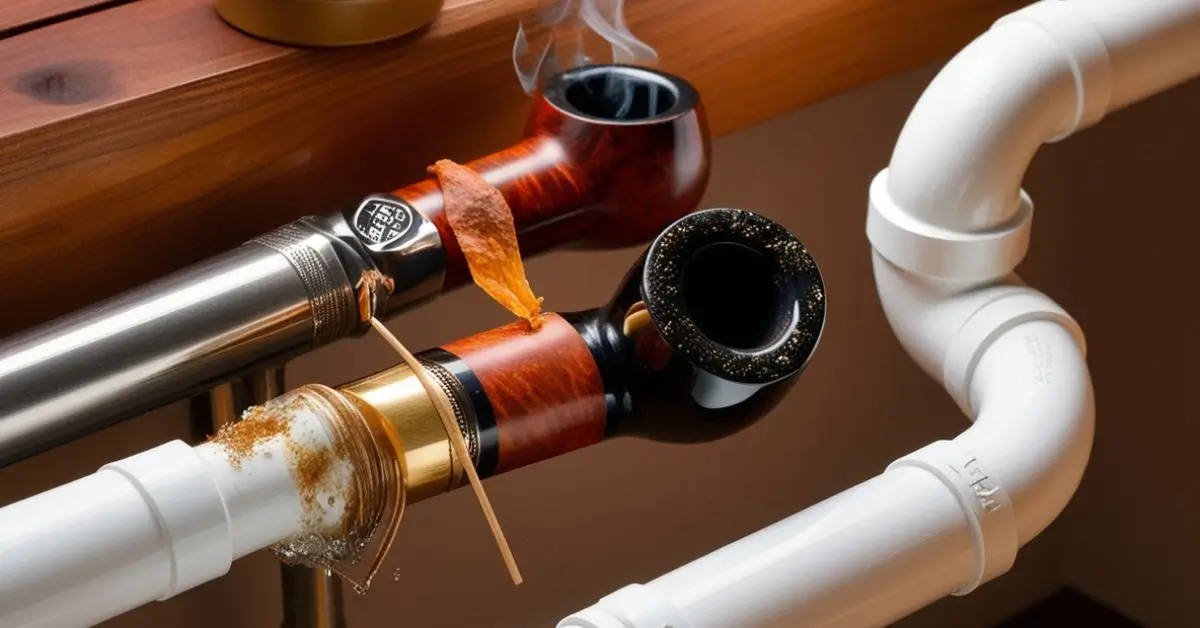When it comes to maintaining pipes, whether they are for smoking or plumbing, cleaning them is crucial for ensuring they perform at their best. Over time, pipes collect residue, buildup, and debris that can reduce their effectiveness. Regular cleaning not only ensures a better experience but also extends the life of the pipe. In this article, we’ll cover how to clean various types of pipes, from tobacco pipes to plumbing pipes, providing you with easy-to-follow methods that will keep your pipes in top condition.
The Importance of Pipe Cleaning
Cleaning pipes is often an overlooked task, but it’s an essential part of proper maintenance. Pipes, regardless of the type, accumulate substances that can affect their functionality, health, and performance. In smoking pipes, for example, tar, resin, and tobacco buildup can alter the flavor of the smoke and make it harder to inhale. In plumbing pipes, mineral deposits, grease, and food waste can cause blockages, foul odors, and even expensive repairs if left untreated. Regular cleaning ensures that pipes remain clear, efficient, and free of health risks.
Types of Pipes and How to Clean Them
There are many different types of pipes, each requiring different cleaning methods. The most common types are smoking pipes, glass smoking pipes, and plumbing pipes. Below, we’ll go into detail about each one and explain the best cleaning techniques.
1. Tobacco Pipes
Tobacco pipes come in a variety of materials such as briar, meerschaum, and corncob. Each material requires a specific cleaning process, but the general principles are the same: removing tobacco residue, preventing moisture buildup, and ensuring that the airflow is clear. Regular cleaning will prevent the tobacco from leaving behind harmful residues that can negatively affect the taste of the smoke.
Cleaning Steps:
- After Each Use: After smoking, empty the bowl of any remaining tobacco or ash. You can use a pipe tool to scrape off any residue gently. Once the bowl is empty, use a pipe cleaner to clean the stem. Run the cleaner through the stem several times to remove any moisture or debris.
- Deep Cleaning: To give your tobacco pipe a thorough cleaning, fill a small container with isopropyl alcohol and add a pinch of salt. Submerge the bowl of the pipe (but not the stem) in the solution and let it soak for a few hours. The alcohol will break down any tar or buildup. After soaking, use a pipe cleaner to scrub the stem and bowl. Let the pipe dry completely before using it again.
2. Glass Smoking Pipes
Glass smoking pipes are known for their durability and ease of use. However, they can accumulate sticky resin and tar that can affect the taste and overall quality of the smoking experience. Regular cleaning will prevent any clogs and improve airflow.
Cleaning Steps:
- Routine Cleaning: Fill a plastic bag with isopropyl alcohol and add a tablespoon of coarse salt. Place your glass pipe inside the bag and seal it. Shake the bag vigorously for several minutes. The salt will act as an abrasive, loosening any residue stuck inside the pipe. After shaking, remove the pipe and rinse it thoroughly with warm water.
- Deep Cleaning: For more stubborn residue, soak your glass pipe in isopropyl alcohol mixed with salt overnight. This will allow the alcohol to dissolve the buildup completely. After soaking, use a pipe cleaner to scrub away any remaining residue. Be sure to rinse the pipe with warm water to remove all alcohol.
3. Plumbing Pipes
Plumbing pipes are often exposed to all kinds of debris, including grease, soap scum, and food waste. These substances can clog your pipes, causing slow drainage, unpleasant odors, and even severe blockages. Keeping your plumbing pipes clean is essential for the proper functioning of your plumbing system.
Cleaning Steps:
- Preventive Maintenance: To avoid clogs and buildup, it’s important to flush your drains regularly with hot water. This helps keep grease and soap scum from accumulating. You can also use a strainer or drain guard to catch food particles and other debris before they enter the drain.
- Clog Removal: If you notice a slow drain, try using a plunger first. Place the plunger over the drain and push up and down several times to create suction. This can help dislodge minor clogs. If the clog persists, use a drain snake to break up the blockage. Insert the snake into the drain and twist it until you feel resistance. This will help push the clog through the pipes.
- Baking Soda and Vinegar: For a more natural approach, you can use a mixture of baking soda and vinegar to clean your plumbing pipes. Pour half a cup of baking soda into the drain, followed by half a cup of vinegar. Let the mixture sit for 10-15 minutes, then flush the drain with hot water. This will help break down grease and other substances that may be clogging the pipes.
4. Copper Pipes
Copper pipes are commonly used in plumbing because of their durability and resistance to corrosion. However, they can still accumulate minerals, debris, and scale buildup over time. Regular cleaning of copper pipes ensures that they remain free from clogs and deposits.
Cleaning Steps:
- Descaling: Copper pipes can develop mineral deposits and scale over time. To clean the pipes, mix equal parts white vinegar and water in a bucket. Use a soft cloth or sponge to wipe down the exterior of the pipes. For interior cleaning, you can use a pipe cleaning brush to remove scale buildup inside the pipes.
- Rinse: After cleaning the pipes with vinegar and water, rinse them thoroughly with clean water to remove any remaining vinegar solution.
How Often Should You Clean Your Pipes?
The frequency of pipe cleaning depends on how often the pipes are used. Smoking pipes should be cleaned after every few uses, especially tobacco pipes, as tobacco buildup can accumulate quickly. Glass smoking pipes, depending on how frequently they are used, may need to be cleaned once a week or more often if you notice a decrease in airflow or a change in taste.
Plumbing pipes should be cleaned on a regular basis to prevent clogs and other issues. For preventive maintenance, flushing drains with hot water once a week is recommended. If you notice any slow drainage or unpleasant odors, it’s a sign that your plumbing pipes need a more thorough cleaning.
Comparison of Cleaning Methods
| Pipe Type | Cleaning Solution | Cleaning Tools | Frequency of Cleaning |
|---|---|---|---|
| Tobacco Pipe | Isopropyl alcohol and salt | Pipe cleaners, pipe tool | After each use |
| Glass Smoking Pipe | Isopropyl alcohol and salt | Pipe cleaners, plastic bag | Weekly or as needed |
| Plumbing Pipes | Baking soda and vinegar, hot water | Plunger, drain snake | Weekly or as needed |
| Copper Pipes | White vinegar and water | Soft cloth, pipe brush | Monthly or as needed |
Tips for Maintaining Clean Pipes
- Proper Storage: Always store your pipes in a dry, clean place. Avoid leaving them exposed to moisture, as this can promote the growth of mold and mildew.
- Avoid Chemical Cleaners: When cleaning your pipes, avoid harsh chemical cleaners, especially for plumbing pipes. These chemicals can damage pipes and the environment.
- Use a Strainer: For plumbing pipes, always use a strainer or drain guard to catch food particles and debris. This will prevent blockages from forming in the first place.
- Rinse Thoroughly: After cleaning any type of pipe, be sure to rinse it thoroughly to remove any cleaning solution or residue. This is especially important for smoking pipes to ensure that the pipe is safe to use.
Conclusion
Regularly cleaning your pipes, whether they are used for smoking or plumbing, is essential for maintaining their functionality and prolonging their lifespan. By following the cleaning methods outlined in this guide, you can ensure that your pipes remain free of residue and buildup, allowing them to perform efficiently and effectively. Clean pipes not only improve your experience but also help prevent costly repairs down the road. Whether you’re a tobacco pipe enthusiast or just trying to keep your plumbing system in top shape, regular pipe maintenance is key to a smoother, more enjoyable experience.












